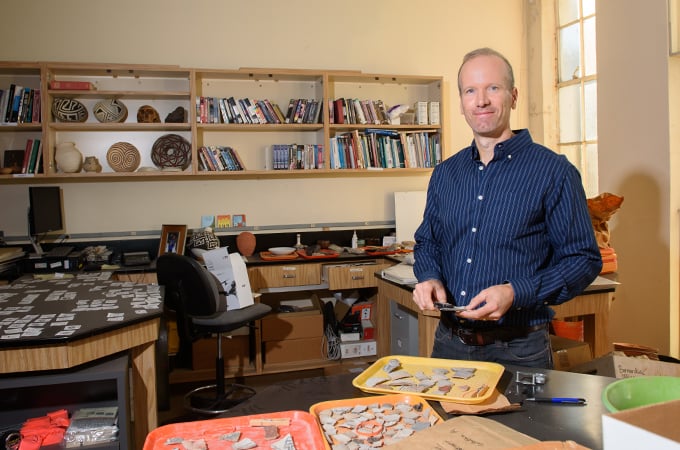When Professor of Anthropology Wes Bernardini was in graduate school, he approached members of the Hopi tribe in northern Arizona about conducting research on their reservation. While most external scholars come to the tribe seeking approval for research plans that have already been finalized, Bernardini sought to have a conversation about topics that might be of mutual interest.
Out of this meeting grew a decades-long partnership between the tribe and the University of Redlands, culminating most recently with Becoming Hopi: A History (The University of Arizona Press, 2021), a new, 600-page volume on Hopi history.
Combining archaeology, oral tradition, ethnography, and historical documents, the book presents 2,000 years of the tribe’s history in an accessible way—with dozens of color illustrations and photographs—and was written with multiple audiences in mind, including academics, tribal members, and the general public.
“The founder of the Hopi Cultural Preservation Office, Leigh Kuwanwiswima, had announced his retirement and was looking back on the 25 years of heritage preservation work overseen by his office,” says Bernardini of the book’s genesis. “He wanted to produce a book that would share this rich information with Hopi Tribal members, not just with other academics."
Leigh’s successor, Stewart Koyiyumptewa, expanded on this vision to emphasize younger generations of Hopi people, recruiting them into the project as artists, interviewees, and co-authors.
Even though Bernardini had been working with the Hopi tribe for over 20 years, compiling the information for the book revealed eye-opening new findings. While the Hopi people are arguably one of the world’s most famous tribes, most publications have focused on two, relatively recent time periods: the 1600s, when Spanish missionaries unsuccessfully tried to convert Hopi people to Christianity; and the early 1900s, when anthropologists first visited Hopi villages. The history of the Hopi people prior to Spanish contact has received much less attention.
The research documented in Becoming Hopi shows that ancestral Hopi people were living in surprisingly large villages that were already attracting immigrants from neighboring regions. Over the next ten centuries, thousands of additional immigrants were drawn to Hopi villages from across the American Southwest, bringing with them diverse religious practices and cultural traditions that would crystalize into a distinctive Hopi identity.
Documenting these migration pathways demonstrates that the Hopi tribe is affiliated with a huge ancestral territory, a fact that was under-appreciated by previous generations of government officials who focused only on where contemporary Hopi villages were located.
“What we’ve learned is that the full story of Hopi history can’t be fully known without tribal input,” Bernardini says. “Archaeology, historical records, and oral traditions complement each other—no one record can stand on its own. There are multiple threads that weave together to tell the story.”
Two Hopi editors participated in every step of the book’s research process and Hopi coauthors contributed to every chapter. Bernardini worked as the book’s senior editor, a lead author on seven of the 12 chapters, and a contributing author on an additional four chapters. He says that producing the book was equivalent to a full-time job for the past five years, and one of the most challenging things he’s done.
All that effort was rewarded when Bernardini was able to present the Hopi tribe with 100 free copies of the book to be distributed to Hopi villages and schools, a purchase that was made possible by the U of R Farquhar Professor of the American Southwest Endowment. During a meeting of the Hopi tribal council, he presented the books to the chairman—an event that was broadcast on the local Hopi radio station.
“It was a really nice moment of closure, and a lot of gratitude was expressed for the people who were involved in the project,” he says, noting that a 30-page magazine version of the book was also printed and distributed to every Hopi household.
Bernardini involves University of Redlands students in his lab and fieldwork, several of whom have gone on to graduate school and careers in archaeology and museum work. He also builds lessons learned from the collaboration into his classes.
“I teach a class on ethics called Politics of The Past that helps students to understand the evolving dynamic between non-Native researchers and Native populations,” he says. “It’s a moral and political history as much as an anthropological and archaeological one. It’s important for students to understand that writing history is a process driven by the dynamics of power. Who has the right to tell the story of a people’s past? Who gets to control the remains of the past in the present?”
Bernardini’s hope is that Becoming Hopi encourages younger generations of the Hopi Tribe to explore their own history more deeply and perhaps even pursue careers in heritage preservation. He is already planning his next trip to the Hopi Reservation to continue his ongoing partnership.
“Each trip adds another piece to the puzzle,” he says, referring to the steady but incremental nature of his work. “And you see the puzzle unfolding that way, rather than envisioning it ahead of time.”
Learn more about studying sociology and anthropology at the U of R.






